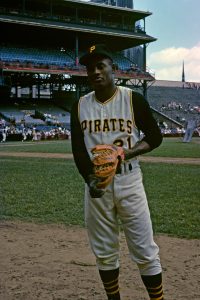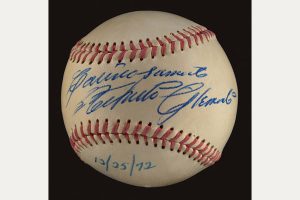An autograph often becomes a fan’s first cherished keepsake, a way to commemorate a personal meeting with a hero. As we mature, few people we meet rise to the level of “heroes.” However, for many local Pittsburghers and Puerto Ricans, Roberto Clemente emerged as, and remains, a hero. This past year we celebrated the 50th anniversary of his 3,000th hit, and now, we sadly mark the 50th anniversary of his tragic passing on Dec. 31, 1972. Roberto Clemente’s name itself in various forms — whether signed as an autograph or now engraved on an award — stands for his pride in family, heritage, greatness, and humanitarianism.
Roberto Clemente’s first significant autograph was his signature on a 1954 Brooklyn Dodgers minor league contract to play for the Montreal Royals. But the Dodgers could not keep him hidden in their farm system, and after a Rule 5 draft claim by Pittsburgh, Roberto signed a 1955 Pirates contract. Montreal newspapers initially and erroneously reported him as “Cuban” and later in Pittsburgh newspapers his first name initially was reported as “Pedro.”
Clemente briefly was assigned uniform number #13 for the Pirates in his rookie season, but soon he donned #21. Some people say the number was chosen to match the number of letters in his name, yet his full name Roberto Enrique Clemente Walker was 28 letters. Acclaimed biographer David Maraniss claimed a clubhouse attendant simply had #21 available. Perhaps more likely is that Roberto, after initially wearing #39, had worn #21 beforehand for the Santurce Cangrejeros (Crabbers) in the Puerto Rican winter league in 1954-1955. While today’s fans sport #21 replica jerseys with “Clemente” across the back, Roberto never wore a Pirates jersey with his name on it.
Louisville Slugger branded many of Clemente’s bats “Momen Clemente” on the barrel through 1960. Growing up, the Clemente family nicknamed him “Momen” for his habit of repeating “momentito” Spanish for “in just a moment” (…please). These Louisville Sluggers (and later Adirondack-brand bats) ultimately belted out the third-most home runs in franchise history (240) — many hit at spacious Forbes Field. Still, Clemente is known as one of the game’s best contact hitters, finishing his career with a .317 average. He personally attested, “I am more valuable to my team hitting .330 than swinging for home runs.”
Following the 1960 World Series, Roberto achieved superstar status. His dramatic and elaborate autograph became highly sought after. It has come to light that long-time Pirates employee Sally O’Leary practiced, and then signed, Clemente’s name when fan mail letters sent to Forbes Field became excessive. Roberto’s close friend and Pittsburgh postal worker Phil Dorsey signed for him as well. No one can satisfy all the fans and often the situation may not be right — yet, still, Roberto very frequently took time to sign for fans. Always “Roberto” and possibly never “Bob” as printed on many of his Topps baseball cards, nor “Bobby” as Pirates broadcaster Bob Prince called him.
Beyond autographs, there are many stories of the Pirates beloved right fielder giving away his gloves, jerseys, bats, and other equipment. The 1960s were a time when fans had more access to players, whether it be an annual photo day at Forbes Field or a chance encounter in East Liberty or Oakland. If a fan addressed Roberto in Spanish, they were likely to receive a smile and a conversation, as well as an autograph.
The 1971 World Series finally directed the national spotlight on Roberto Clemente, as his play earned him long-deserved acclaim. After his 3,000th hit in his last regular season at-bat on Sept. 30, 1972, and then a disappointing playoff loss to the Cincinnati Reds, Clemente became an Eastern Airlines spokesperson. He signed many baseballs stamped with the airline’s name and even filmed a commercial for Eastern on Three Rivers Stadium’s turf with Puerto Rican Little Leaguers. In December, he managed the Puerto Rican team in the 1972 Amateur World Series, an international championship held in the Central American country Nicaragua. Roberto had first played winter league ball there in 1964 when he starred as a member of the San Juan Senadores.
Two historic events occurred on Dec. 23, 1972, that significantly impacted the courses of the Pittsburgh Steelers and Pittsburgh Pirates for the rest of the decade. Franco Harris’ Immaculate Reception turned the tide towards future success for the Steelers. But in the early morning hours that same day, an earthquake hit Managua, Nicaragua, that contributed to the deaths of more than 10,000 people.
Clemente was deeply affected, as he felt emotionally connected to the people of Nicaragua. He quickly coordinated the humanitarian relief effort of collecting supplies in Puerto Rico. Some food and supplies were not getting through to those Nicaraguans who desperately needed them as shipments were stopped by corrupt government officials and military troops. In Clemente’s mind, if he escorted the supplies personally and if his name was known as the source — they would not steal from “Roberto Clemente.” Tragically, as Pittsburgh and the world soon learned, 38-year-old Roberto died along with four other people in the plane crash off Puerto Rico’s coast on Dec. 31, 1972. Franco Harris’ recent passing brings up similar feelings of deep loss within our Pittsburgh family.
Before the following baseball season, 1973, the five-year waiting period after the end of a player’s career was waived and Clemente was immediately inducted into the National Baseball Hall of Fame. The right fielder was the first Latin American player enshrined. His plaque initially read “Roberto Walker Clemente.” Decades later a new plaque was created which now reads “Roberto Clemente Walker” as is the custom in Latin American countries where the father’s surname traditionally appears before the mother’s maiden name.
Roberto Clemente’s name and legacy live on in so many tributes, one being the annual Roberto Clemente Award. First presented in 1971 as the “Commissioners Award” it was renamed the Roberto Clemente Award in 1973. According to Major League Baseball, “The Roberto Clemente Award is bestowed annually to the player who best represents the game of baseball through extraordinary character, community involvement, philanthropy and positive contributions, both on and off the field.” Many fans now refer to Roberto as “The Great One.”
Roberto Clemente’s name, autograph, striking image, and the equipment he used continue to resonate with fans. Sought after memorabilia provides a personal connection to a complicated and talented man who became revered and loved here and around the world. Not perfect and flawed, as is anyone, he nevertheless represented more of what we can aim to be. Whether wearing his number or collecting his trading cards, autographs, and other memorabilia, these pieces provide an intimate way of preserving Clemente’s name and life story.
About the Author
Craig Britcher is the assistant curator of the Western Pennsylvania Sports Museum at the History Center.






